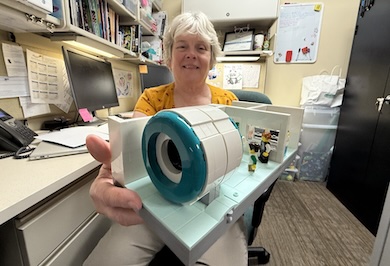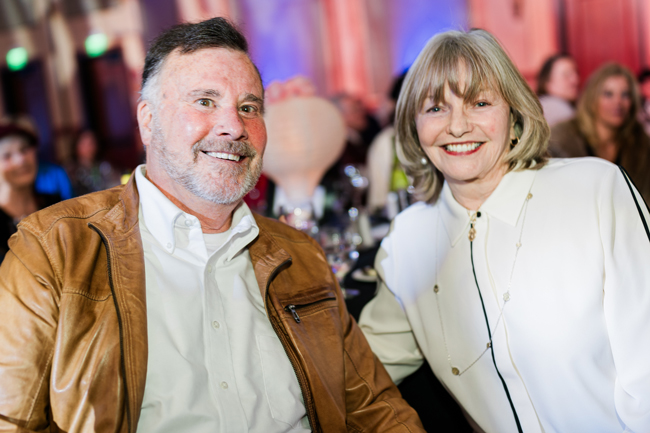Jeri Young’s office at St. Charles’ Bend hospital is an unexpected blend of common, neutral-colored work supplies — folders, computer monitors, a stapler — and shelves stuffed with colorful toys and books for kids.
Young is one of the health system’s three child life specialists, whose job, broadly speaking, is to help kids cope with challenging health care experiences through play, self-expression activities and age-appropriate medical education. So, for example, Young might meet with a child and their family to discuss an upcoming procedure, practice stress-relieving techniques and facilitate communication with the clinical care team.
Tools of the trade include toys, and Young is excited about a new one she has on her shelf: A LEGO® MRI Scanner — three of them, actually — designed specifically by LEGO® to help children cope with the uncertainty of having a Magnetic Resonance Imaging (MRI) scan.
Measuring about 10 inches long, 5 inches wide and 4 inches tall when constructed, the kit provides a remarkably detailed replica of the MRI experience, including a waiting room, a space for MRI techs and their computers, and an MRI machine that swings open to provide a peek inside.
It’s a major upgrade from the tools Young has used in the past, including children’s books about the MRI process and a toy CT scanner that looks kind of like an MRI scanner, but not exactly.
“We have kids who we’re asking to lay still for up to an hour or longer, and that’s really challenging,” said Young, pictured above with a kit. “Some kids are scared, and most have a lot of questions: What’s going to happen? How does it work? Will it be noisy? Why do I have to be alone? We can show them pictures, but it just doesn’t have the same effect as giving them something they can manipulate.”
Indeed, the LEGO scanner was developed “with a child-centered focus” and “is a means for clinicians to facilitate both role play and dialogue so that the child feels safe and can build confidence and resilience before the actual journey, in turn reducing stress and anxiety,” according to the company’s website. “Play motivates the child’s natural curiosity and openness to try new, sometimes difficult, experiences.”
Scott Waite saw that effect firsthand. In May, he walked into St. Charles’ Bend hospital for his daughter’s MRI, braced for what he expected to be a tough day.
Avalyn, 7, had had an MRI several months before at a different facility, and it was “a very traumatic experience,” Waite said.
“She came out of the scanner sweating profusely. She cried the whole time. And the pictures were blurry, so the doctor asked for a second one,” he said. “When we told her she’d have to do it again, she was so nervous. And we were nervous, too.”
Shortly after arriving, the family was met by Young, who had the LEGO scanner in hand. Young said she sometimes meets with up to a half-dozen children getting an MRI in a day.
“She started making jokes with Avalyn and talking to her stuffed animal and just generally doing things to take her mind off what she was there for,” Waite said.
“And Avalyn loved the LEGO model. She played with it, and Jeri explained all the parts and how it works and all kinds of things. It was wonderful,” he continued. “By the time she was headed back for the procedure, she was smiling and so much more comfortable.”
Young has been trying to acquire a LEGO MRI scanner for about three years, but they were hard to find for a long time, she said. (“They’re wildly popular in our profession,” Young said.) Then, earlier this year, she noticed they were being offered on the website of the Starlight Children’s Foundation, an organization that supports hospitalized kids by providing toys, games, movies and more to hundreds of hospitals across the country.
She signed up for a kit, and Starlight asked if she’d be willing to share feedback on its impact.
“I messaged them right back: ‘You bet I will. I’ll do whatever it takes,’” she said. “When the first one arrived, I went down to show the nurses and techs and anesthesiologists who work with the MRI — they might’ve been more excited about it than the kids.”
The kit’s attention to detail — the moveable parts, the insides of the machine and so on — encourages extended play, which leads to important conversations with both children and their families. (“Many of the parents haven’t ever had an MRI either,” Young said.) Those conversations give her an opportunity to probe for stress points, to identify and correct misperceptions, and to convey to kids the importance of staying still during the procedure.
Calmer, more informed patients, of course, make St. Charles caregivers’ jobs easier and usually result in better scans.
“It’s just so important to have something that kids can manipulate, because that’s how they learn — by playing and touching and feeling and being in control,” Young said. “It’s been incredible to watch their reaction, and to see them be like, ‘Oh, I’ve got this. It’s easy.’”
Parents can have that reaction too, said Avalyn’s dad, Scott Waite.
“It was so refreshing not having to do it alone. It gave us a chance to step back and take a breath and process and go, ‘She’s going to be OK,” he said.
“And it was so reassuring to see her smiling before the procedure instead of shaking like she was the first time,” he continued. “When I asked Avalyn what she remembered about Jeri, she said, ‘She helped me not be scared.’”





